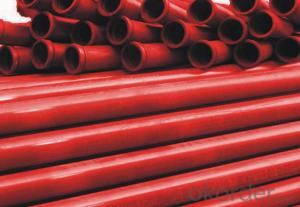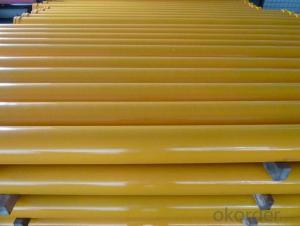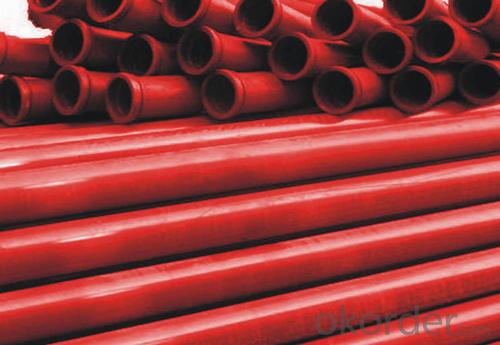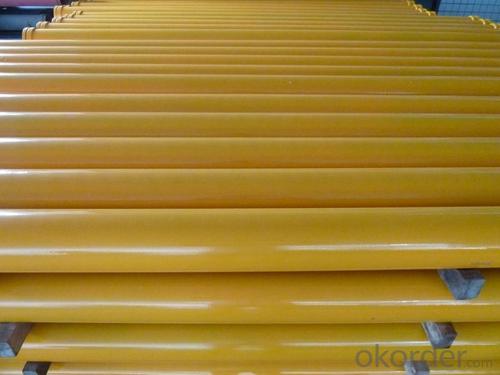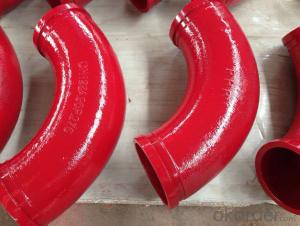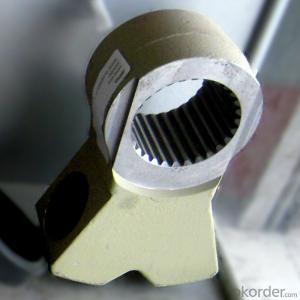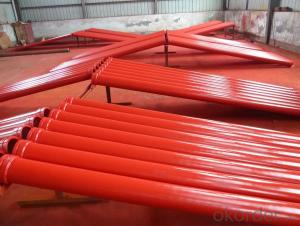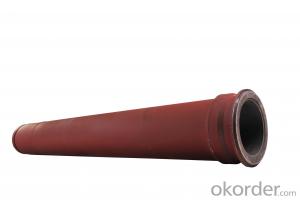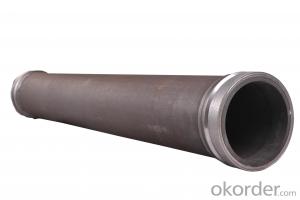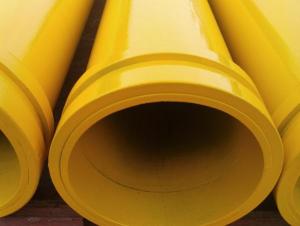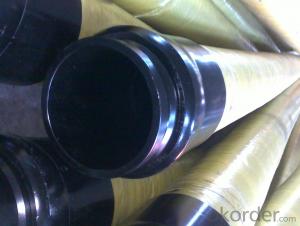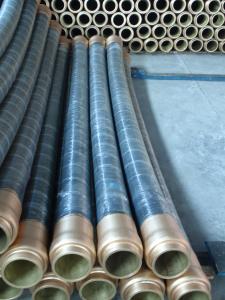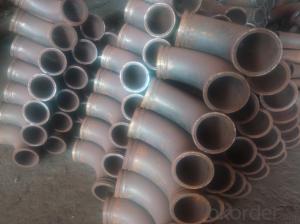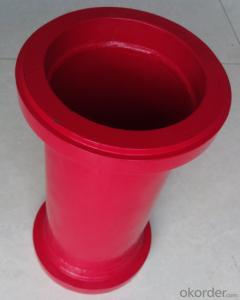Twin Wall Pipe for Concrete Pump Pipe Thickness 4.5mm Length 1000mm
- Loading Port:
- Tianjin
- Payment Terms:
- TT OR LC
- Min Order Qty:
- 50 pc
- Supply Capability:
- 2000 pc/month
OKorder Service Pledge
OKorder Financial Service
You Might Also Like
1. Diameter: DN125
2. Wall thickness: inner wall is 2.5 mm 65Mn, outer wall is 2mm seamless steel
3. Length: 3000&2000&1000mm with wear resistant SK flange
4. Type: Double / twin wall
5. Hardness: HRC 63
6. Using life: 60,000-100,000(CBM)
7. Highlights: longest using life
8. Welding: Smooth welding between straight pipes and flanges
9. Color : as customer's requirement,usually bule or red
10. Surface: Electrostatic Spraying Epoxy Paint
11. Packing: Wrapped by water proof poly-bag to protect the
painting and flanges & seaworthy
or according to customers’ requirements.
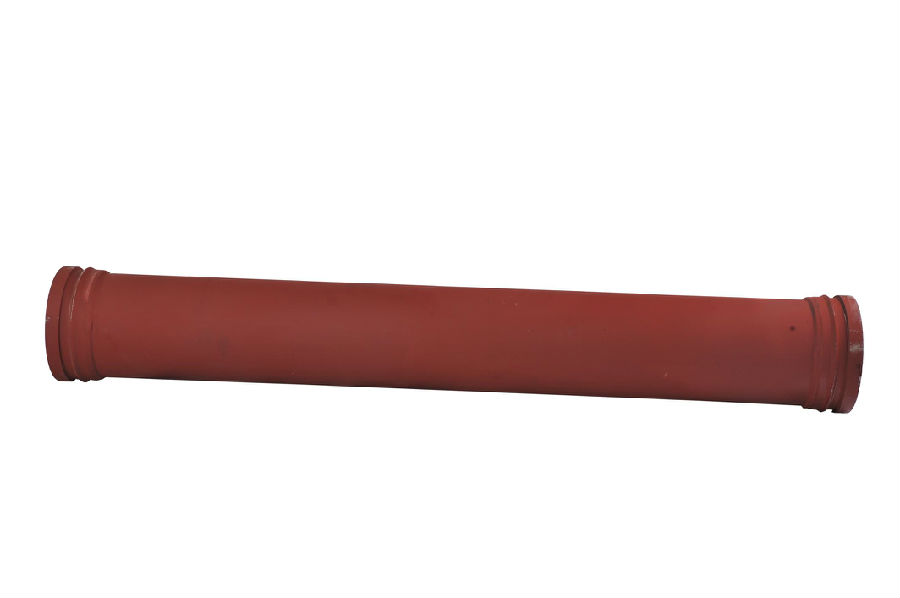
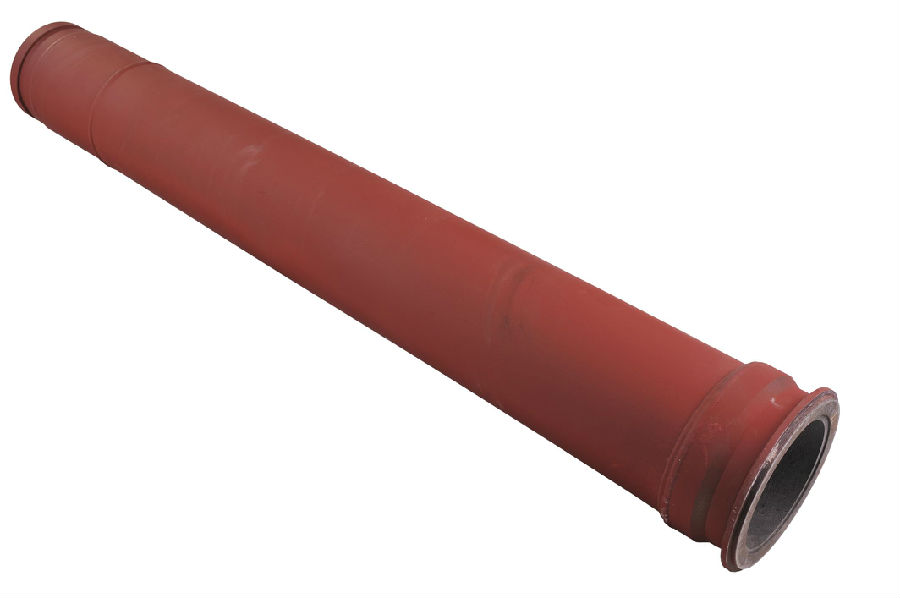
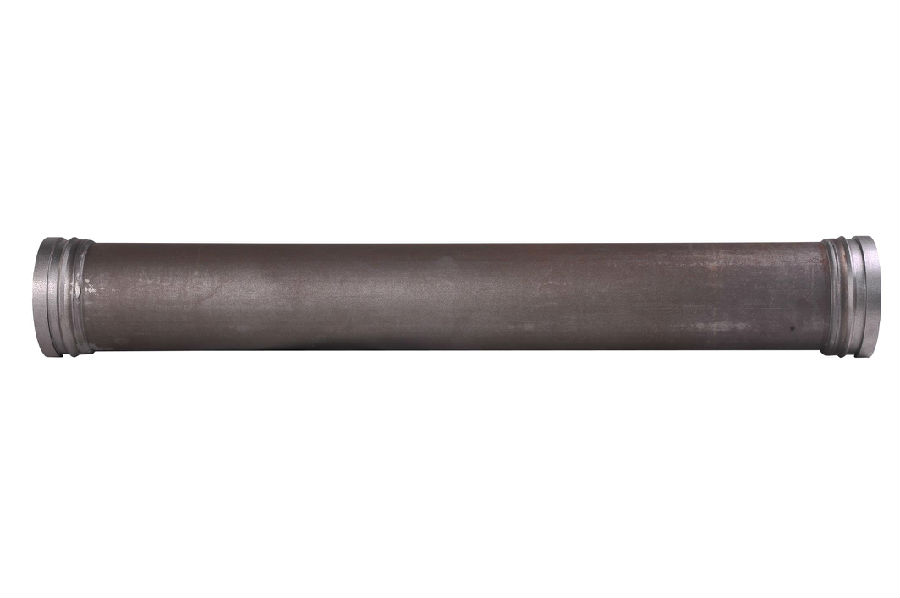
- Q: Where can I buy concrete pump spare parts?
- You can buy concrete pump spare parts from various suppliers and manufacturers. Some common places to find these spare parts include specialized construction equipment stores, online marketplaces, and directly from the manufacturer's website.
- Q: What is the function of a concrete pump hydraulic filter?
- The concrete pump hydraulic filter serves to eliminate impurities and contaminants from the hydraulic fluid, which is responsible for the pump's operation. Its purpose is to capture particles like dirt, debris, and metal fragments that might be in the hydraulic system. By removing these contaminants, the filter guarantees that the hydraulic fluid remains clean and devoid of any harmful particles that could cause damage. This, in turn, keeps the concrete pump functioning smoothly and for a longer period of time, as it prevents blockages, wear and tear, and potential harm to the hydraulic components. Furthermore, a clean hydraulic system minimizes the risk of hydraulic fluid leakage, which can result in expensive repairs and downtime. Hence, the concrete pump hydraulic filter is crucial in ensuring the effectiveness, dependability, and resilience of the hydraulic system.
- Q: What are the common challenges in sourcing spare parts for stationary concrete pumps?
- Sourcing spare parts for stationary concrete pumps can pose several common challenges. Firstly, one of the major challenges is availability. Depending on the brand and model of the concrete pump, finding the exact spare parts needed may be difficult. Some manufacturers may not have a wide distribution network, which can make it challenging to locate the required spare parts in a timely manner. This issue can be exacerbated if the concrete pump is an older model or if the manufacturer has discontinued production. Secondly, cost is another significant challenge. Spare parts for stationary concrete pumps can be expensive, especially if they are sourced directly from the manufacturer. In addition to the initial cost, there may be additional expenses such as shipping, customs duties, and taxes, further increasing the overall cost of sourcing spare parts. Thirdly, quality assurance is crucial when sourcing spare parts. It is essential to ensure that the spare parts being sourced are of high quality and compatible with the specific make and model of the concrete pump. Poor-quality spare parts can lead to performance issues, breakdowns, and potentially safety hazards, which can be detrimental to the overall efficiency and longevity of the concrete pump. Furthermore, timing plays a vital role in sourcing spare parts. When a concrete pump breaks down, it can result in delays in construction projects, leading to additional costs and potential penalties. Therefore, finding spare parts quickly and efficiently is crucial to minimize downtime and ensure smooth operations. Lastly, language and communication barriers can also present challenges. If the manufacturer or supplier of the spare parts is located in a different country or speaks a different language, effective communication can be challenging. This can lead to misunderstandings, delays, and difficulties in accurately conveying the specific spare parts requirements. To overcome these challenges, it is advisable to work with reputable suppliers who specialize in concrete pump spare parts. These suppliers often have a wide range of spare parts in stock, ensuring availability and reducing the risk of delays. Additionally, establishing strong relationships with local distributors or authorized service centers can provide access to spare parts and technical support more efficiently. Regular maintenance and proactive planning can also help mitigate the challenges of sourcing spare parts for stationary concrete pumps. Keeping an inventory of essential spare parts and components can minimize downtime and ensure smooth operations.
- Q: How does a hopper agitator blade ensure smooth concrete flow?
- A hopper agitator blade ensures smooth concrete flow by constantly mixing and agitating the concrete inside the hopper. This prevents the concrete from settling or forming clumps, ensuring a consistent and even flow of the material. The agitation action of the blade also helps to break up any air pockets that may be present in the concrete, resulting in a more uniform and high-quality mixture.
- Q: How do I properly maintain and replace rubber pistons in concrete pump spare parts?
- Proper maintenance and replacement of rubber pistons in concrete pump spare parts involves a few key steps. Firstly, make sure to regularly inspect the pistons for any signs of wear, such as cracks or tears. It is recommended to replace them if they are significantly worn or damaged. To replace the rubber pistons, start by removing the old piston carefully, ensuring not to damage the cylinder or any other components. Clean the cylinder thoroughly, removing any debris or residue. Apply a lubricant or concrete pump primer to the cylinder walls to aid in the installation of the new piston. Next, carefully install the new rubber piston, ensuring it is properly aligned with the cylinder. Gently push it into place, avoiding any unnecessary force that could cause damage. It is important to refer to the manufacturer's instructions or guidelines for specific installation techniques. After replacing the rubber piston, run a few tests to ensure its proper functioning. Check for proper sealing and smooth operation by conducting a dry run or pumping a small amount of concrete. Monitor the piston's performance closely, and if any issues arise, consult a professional or the manufacturer for further guidance. Regular maintenance, such as cleaning the cylinder and lubricating the pistons, can help extend their lifespan. Additionally, following proper operating procedures, such as avoiding excessive pressure or abrasive materials, can also contribute to the longevity of rubber pistons.
- Q: How do I troubleshoot common problems with concrete pump spare parts?
- Troubleshooting common problems with concrete pump spare parts can be done through a systematic approach. Here are some steps to help you identify and resolve issues: 1. Identify the problem: Start by observing the symptoms and identifying the specific issue you are facing. This can include leaks, reduced pumping efficiency, abnormal noise, or power failure. 2. Check for clogs or blockages: Inspect the pump's hoses, pipes, and valves for any clogs or blockages that may be hindering the flow of concrete. Clear out any debris or obstructions that you find. 3. Inspect the wear parts: Examine the wear parts such as the pump's pistons, seals, or gaskets. Look for signs of wear and tear, cracks, or damage. If necessary, replace any worn-out parts. 4. Check for air leaks: Air leaks can affect the pump's performance and efficiency. Inspect the fittings, connections, and seals for any signs of air leakage. Tighten loose fittings or replace faulty seals as needed. 5. Ensure proper lubrication: Lack of lubrication can cause friction and damage to the pump's moving parts. Check the lubrication system and ensure that it is functioning properly. Add lubricant if necessary. 6. Verify electrical connections: If you are experiencing power failure or electrical issues, check the electrical connections of the pump. Look for loose or damaged wires and connections. Repair or replace any faulty components. 7. Consult the manufacturer's manual: The manufacturer's manual can provide valuable troubleshooting information specific to your concrete pump spare parts. Refer to the manual to understand the recommended maintenance procedures and troubleshooting steps. 8. Seek professional assistance if needed: If you are unable to identify or resolve the issue on your own, it is advisable to seek professional assistance. Contact a qualified technician or the manufacturer's customer support for further guidance and support. Remember, regular maintenance and proper usage of concrete pump spare parts can minimize the occurrence of problems.
- Q: What are the different types of concrete pump hoses?
- There are generally two types of concrete pump hoses: steel-reinforced hoses and fabric-reinforced hoses. Steel-reinforced hoses are stronger and more durable, suitable for high-pressure applications and long-distance pumping. Fabric-reinforced hoses are lightweight and flexible, ideal for smaller projects and shorter pumping distances.
- Q: How can a faulty oil cooler affect the pump's hydraulic system?
- A faulty oil cooler can affect the pump's hydraulic system in several ways. Firstly, the oil cooler is responsible for maintaining the optimal temperature of the hydraulic oil. If the oil cooler is faulty and fails to cool the oil effectively, the hydraulic oil may overheat. This can lead to a decrease in the oil's viscosity, causing it to lose its lubricating properties. As a result, the pump's moving parts may experience increased friction and wear, leading to reduced efficiency and potentially causing damage to the pump itself. Secondly, a faulty oil cooler may result in inadequate cooling of the hydraulic oil, leading to elevated temperatures within the system. High temperatures can cause the oil to oxidize, resulting in the formation of sludge and varnish deposits. These deposits can clog the hydraulic system, including the pump, valves, and other components, impeding their smooth operation and potentially causing them to malfunction. Additionally, a faulty oil cooler may also lead to a decrease in oil flow rate. If the oil cooler is not functioning properly, it may restrict the flow of hydraulic oil, reducing the amount of oil available for the pump's operation. This can result in decreased hydraulic pressure, affecting the pump's performance and potentially leading to issues such as reduced power output or inadequate operation of hydraulic actuators. Overall, a faulty oil cooler can negatively impact the pump's hydraulic system by causing overheating, increased friction and wear, the formation of deposits, and reduced oil flow rate. It is crucial to regularly inspect and maintain the oil cooler to ensure its proper functioning and prevent any potential damage to the hydraulic system.
- Q: What are the advantages of using OEM (Original Equipment Manufacturer) concrete pump spare parts?
- There are several advantages of using OEM concrete pump spare parts. Firstly, OEM parts are specifically designed and manufactured by the original equipment manufacturer, ensuring a perfect fit and compatibility with your concrete pump. This results in optimal performance and efficiency, minimizing downtime and costly repairs. Secondly, OEM parts are made from high-quality materials, meeting strict industry standards and specifications. This guarantees durability and longevity, reducing the need for frequent replacements. Additionally, OEM parts often come with warranties, providing peace of mind and protection against any manufacturing defects. Lastly, using OEM parts ensures the preservation of your concrete pump's warranty and resale value. Overall, opting for OEM concrete pump spare parts ensures reliability, performance, and cost-effectiveness in the long run.
- Q: Can I get spare parts for concrete pump accessories like remote control systems?
- Certainly, spare parts for concrete pump accessories like remote control systems can be obtained. A variety of spare parts for these products are offered by numerous manufacturers and suppliers of concrete pump accessories. These spare parts encompass various components for remote control systems, including buttons, switches, sensors, batteries, and transmitters. To ensure the availability of spare parts for your particular model of remote control system, it is advisable to directly contact the manufacturer or supplier. They will be equipped to furnish you with the essential information and aid you in procuring the necessary spare parts.
Send your message to us
Twin Wall Pipe for Concrete Pump Pipe Thickness 4.5mm Length 1000mm
- Loading Port:
- Tianjin
- Payment Terms:
- TT OR LC
- Min Order Qty:
- 50 pc
- Supply Capability:
- 2000 pc/month
OKorder Service Pledge
OKorder Financial Service
Similar products
Hot products
Hot Searches
Related keywords
